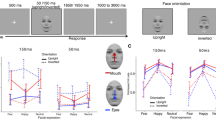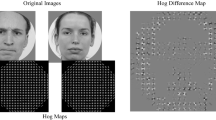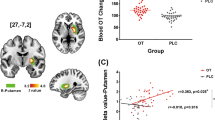Abstract
Many studies have highlighted the potential of oxytocin (OT) to enhance facial affect recognition in healthy humans. However, inconsistencies have emerged with regard to the influence of OT on the recognition of specific emotional expressions (happy, angry, fear, surprise, disgust, and sadness). In this study, we conducted a meta-analysis of seven studies comprising 381 research participants (71 females) examining responses to the basic emotion types to assess whether OT enhances the recognition of emotion from human faces and whether this was influenced by the emotion expression and exposure time of the face. Results showed that intranasal OT administration enhances emotion recognition of faces overall, with a Hedges g effect size of 0.29. When analysis was restricted to facial expression types, significant effects of OT on recognition accuracy were specifically found for the recognition of happy and fear faces. We also found that effect sizes increased to moderate when exposure time of the photograph was restricted to early phase recognition (<300 ms) for happy and angry faces, or later phase recognition for fear faces (>300 ms). The results of the meta-analysis further suggest that OT has potential as a treatment to improve the recognition of emotion in faces, allowing individuals to improve their insight into the intentions, desires, and mental states of others.
Similar content being viewed by others
Log in or create a free account to read this content
Gain free access to this article, as well as selected content from this journal and more on nature.com
or
References
Alvares GA, Hickie IB, Guastella AJ (2010). Acute effects of intranasal oxytocin on subjective and behavioral responses to social rejection. Exp Clin Psychopharmacol 18: 316–321.
Andari E, Duhamel JR, Zalla T, Herbrecht E, Leboyer M, Sirigu A (2010). Promoting social behavior with oxytocin in high-functioning autism spectrum disorders. Proc Natl Acad Sci USA 107: 4389–4394.
Begg C (1994). Publication bias. The Handbook of Research Synthesis. Sage Publications.
Bertrand MC, Sutton H, Achim AM, Malla AK, Lepage M (2007). Social cognitive impairments in first episode psychosis. Schizophr Res 95: 124–133.
Borenstein M, Hedges L, Higgins J, Rothstein H (2005) Comprehensive Meta-analysis Version 2. Englewood, NJ: Biostat.
Borenstein M, Hedges LV, Higgins JPT, Rothstein HR (2009) Introduction to Meta-Analysis. Wiley: New York, NY, USA.
Calder AJ, Young AW (2005). Understanding the recognition of facial identity and facial expression. Nat Rev Neurosc 6: 641–652.
Calvo MG, Lundqvist D (2008). Facial expressions of emotion (KDEF): identification under different display-duration conditions. Behav Res Methods 40 (1): 109–115.
Carton J, Kessler E, Pape C (1999). Nonverbal decoding skills and relationship well-being in adults. J Nonverbal Behav 23: 91–100.
Critchley H, Daly E, Phillips M, Brammer M, Bullmore E, Williams S et al (2000). Explicit and implicit neural mechanisms for processing of social information from facial expressions: a functional magnetic resonance imaging study. Hum Brain Mapp 9: 93–105.
Del Cul A, Baillet S, Dehaene S (2007). Brain dynamics underlying the nonlinear threshold for access to consciousness. PLoS Bio 5: e260.
Domes G, Heinrichs M, Gläscher J, Büchel C, Braus DF, Herpertz SC (2007). Oxytocin attenuates amygdala responses to emotional faces regardless of valence. Biol Psychiatry 62: 1187–1190.
Domes G, Sibold M, Schulze L, Lischke A, Herpertz SC, Heinrichs M (2012a). Intranasal oxytocin increases covert attention to positive social cues. Psychol Med (e-pub ahead of print).
Domes G, Steiner A, Porges SW, Heinrichs M (2012b). Oxytocin differentially modulates eye gaze to naturalistic social signals of happiness and anger. Psychoneuroendocrinology 12: 00337–X.
Ebner NC, Riediger M, Lindenberger U (2010). FACES—a database of facial expressions in young, middle-aged, and older women and men: development and validation. Behav Res Methods 42: 351–362.
Ekman P, Friesen W (1976) The Pictures of Facial Affect Database. Consulting Psychologists Press: Palo Alto, CA, USA.
Ekman P, Sorenson ER, Friesen WV (1969). Pan-cultural elements in facial displays of emotion. Science (New York, NY) 164: 86–88.
Elfenbein HA, Ambady N (2002). On the universality and cultural specificity of emotion recognition: a meta-analysis. Psychol Bull 128: 203–235.
Ellenbogen MA, Linnen A, Grumet R, Cardoso C (2012). The acute effects of intranasal oxytocin on automatic and effortful attentional shifting to emotional faces. Psychophysiology 49: 128–137.
Fischer-Shofty M, Shamay-Tsoory SG, Harari H, Levkovitz Y (2010). The effect of intranasal administration of oxytocin on fear recognition. Neuropsychologia 48: 179–184.
Fox E, Lester V, Russo R, Bowles RJ, Pichler A, Dutton K (2000). Facial expressions of emotion: are angry faces detected more efficiently? Cogn Emot 14: 61–92.
Garner M, Baldwin DS, Bradley BP, Mogg K (2009). Impaired identification of fearful faces in generalised social phobia. J Affect Disord 115: 460–465.
Goldman MB, Gomes AM, Carter CS, Lee R (2011). Divergent effects of two different doses of intranasal oxytocin on facial affect discrimination in schizophrenic patients with and without polydipsia. Psychopharmacology 216: 101–110.
Gronenschild E, Smeets F (2009). The use of faces as stimuli in neuroimaging and psychological experiments: a procedure to standardize stimulus features. Behav Res Methods 41: 1053–1060.
Guastella AJ, Einfeld SL, Gray KM, Rinehart NJ, Tonge BJ, Lambert TJ et al (2010). Intranasal oxytocin improves emotion recognition for youth with autism spectrum disorders. Biol Psychiatry 67: 692–694.
Guastella AJ, Hickie IB, McGuinness MM, Otis M, Woods E, Disinger H (2013). Recommendations for the standardisation of oxytocin nasal administration and guidelines for its reporting in human research. Psychoneuroendocrinology 38: 612–625.
Guastella AJ, Howard AL, Dadds MR, Mitchell PB, Carson DS (2009). A randomized controlled trial of intranasal oxytocin as an adjunct to exposure therapy for Social Anxiety Disorder. Psychoneuroendocrinology 34: 917–923.
Guastella AJ, Macleod C (2012). A critical review of the influence of oxytocin nasal spray on social cognition in humans: evidence and future directions. Horm Behav 61: 773.
Hess U, Blairy S, Kleck RE (1997). The intensity of emotional facial expressions and decoding accuracy. J Nonverbal Behav 21: 241–257.
Insel T, Young L (2000). Neuropeptides and the evolution of social behavior. Curr Opin Neurobiol 10: 784–789.
Jesso S, Morlog D, Ross S, Pell MD, Pasternak SH, Mitchell DGV et al (2011). The effects of oxytocin on social cognition and behaviour in frontotemporal dementia. Brain 134 (Part 9): 2493–2501.
Kemp AH, Quintana DS, Kuhnert RL, Griffiths K, Hickie IB, Guastella AJ (2012). Oxytocin increases heart rate variability in humans at rest: implications for social approach-related motivation and capacity for social engagement. PLoS One 7: e44014.
Kemp AH, Guastella AJ (2011). The role of oxytocin in human affect: a novel hypothesis. Curr Direct Psychol Sci 20: 222–231.
Kirsch P, Esslinger C, Chen Q, Mier D, Lis S, Siddhanti S et al (2005). Oxytocin modulates neural circuitry for social cognition and fear in humans. J Neurosci 25: 11489–11493.
Leknes S, Wessberg J, Ellingsen DM, Chelnokova O, Olausson H, Laeng B (2012). Oxytocin enhances pupil dilation and sensitivity to ‘hidden’ emotional expressions. Soc Cogn Affect Neurosci (e-pub ahead of print).
Leppänen JM, Hietanen JK (2004). Positive facial expressions are recognized faster than negative facial expressions, but why? Psychol Res 69: 22–29.
Lischke A., Berger C., Prehn K., Heinrichs M., Herpertz S. C., Domes G. (2012). Intranasal oxytocin enhances emotion recognition from dynamic facial expressions and leaves eye-gaze unaffected. Psychoneuroendocrinology 37: 475–481.
Losh M, Adolphs R, Poe MD, Couture S, Penn D, Baranek GT et al (2009). Neuropsychological profile of autism and the broad autism phenotype. Archiv Gen Psychiatry 66: 518–26.
Macdonald K, Macdonald TM (2010). The peptide that binds: a systematic review of oxytocin and its prosocial effects in humans. Harvard Review Psychiatry 18: 1–21.
Marsh AA, Kozak MN, Ambady N (2007). Accurate identification of fear facial expressions predicts prosocial behavior. Emotion 7: 239–251.
Marsh AA, RJR Blair (2008). Deficits in facial affect recognition among antisocial populations: a meta-analysis. Neurosci Biobehav Rev 32: 454–465.
Marsh AA, Yu HH, Pine DS, Blair RJR (2010). Oxytocin improves specific recognition of positive facial expressions. Psychopharmacology 209: 225–332.
Mcclure EB, Nowicki S (2001). Associations between social anxiety and nonverbal processing skill in preadolescent boys and girls. J Nonverbal Behav 25: 3–19.
Moher D, Cook DJ, Eastwood S, Olkin I, Rennie D, Stroup DF (2000). Improving the quality of reports of meta-analyses of randomised controlled trials: The QUOROM Statement. Onkologie 23: 597–602.
Moher D, Liberati A, Tetzlaff J, Altman DG, Group TP (2009). Preferred reporting items for systematic reviews and meta-analyses: The PRISMA Statement. PLoS Clin Trials 6: e1000097.
Schulze L, Lischke A, Greif J, Herpertz SC, Heinrichs M, Domes G (2011). Oxytocin increases recognition of masked emotional faces. Psychoneuroendocrinology 36: 1378–1382.
Shultz S, Dunbar RI (2012). The social brain hypothesis: an evolutionary perspective on the neurobiology of social behavior. In: Richmond S, Rees G, Edwards S (eds.) I Know What You’re Thinking: Brain Imaging and Mental Privacy. Oxford University Press.
Theodoridou A, Rowe AC, Penton-Voak IS, Rogers PJ (2009). Oxytocin and social perception: oxytocin increases perceived facial trustworthiness and attractiveness. Horm Behav 56: 128–132.
Van IJzendoorn MH, Bakermans-Kranenburg MJ (2012). A sniff of trust: meta-analysis of the effects of intranasal oxytocin administration on face recognition, trust to in-group, and trust to out-group. Psychoneuroendocrinology 37: 438–443.
Acknowledgements
We thank Gail Alvares for comments on this manuscript and Jonathan Krygier for assisting with article preparation. This manuscript was partially supported by an ARC linkage project LP110100513 to Guastella. AHK is supported by a National Health and Medical Research Council (NHMRC) career development fellowship (571101).
Author information
Authors and Affiliations
Corresponding authors
Ethics declarations
Competing interests
The authors declare no conflict of interest.
PowerPoint slides
Rights and permissions
About this article
Cite this article
Shahrestani, S., Kemp, A. & Guastella, A. The Impact of a Single Administration of Intranasal Oxytocin on the Recognition of Basic Emotions in Humans: A Meta-Analysis. Neuropsychopharmacol 38, 1929–1936 (2013). https://doi.org/10.1038/npp.2013.86
Received:
Revised:
Accepted:
Published:
Issue date:
DOI: https://doi.org/10.1038/npp.2013.86
Keywords
This article is cited by
-
Oxytocin normalizes the implicit processing of fearful faces in psychopathy: a randomized crossover study using fMRI
Nature Mental Health (2023)
-
Oxytocin and the social facilitation of placebo effects
Molecular Psychiatry (2022)
-
Oxytocin enhances neural approach towards social and non-social stimuli of high personal relevance
Scientific Reports (2021)
-
Intranasal oxytocin enhances the perception of ambiguous averted gaze in women but not in men
Psychopharmacology (2021)
-
Intranasal oxytocin decreases fear generalization in males, but does not modulate discrimination threshold
Psychopharmacology (2021)



